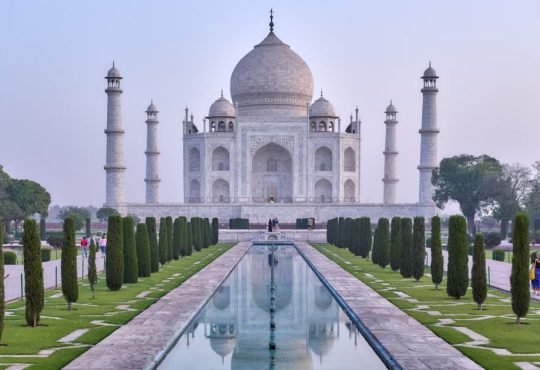Famous art galleries are havens of human creativity, housing countless masterpieces adored by art enthusiasts worldwide. Each gallery features a distinctive collection that preserves centuries of cultural heritage and continually explores new realms of artistic innovation. These institutions serve as repositories of renowned artworks and as dynamic spaces where creativity thrives and historical narratives unfold. Visiting these galleries offers a profound journey through the evolution and diversity of artistic expression across time and cultures.
World’s Most Famous Art Galleries: Top 10 Must-See Exhibits!
Louvre in Paris, France
The Louvre in Paris, France, is synonymous with world-renowned art galleries, attracting visitors globally to its grand Louvre Palace. Originally a medieval fortress built in the late 12th century, the palace symbolized cultural heritage and artistic excellence. Since transforming into a public museum during the French Revolution in 1793, the Louvre has curated a staggering collection of over 38,000 artworks spanning ancient civilizations to the 19th century. Iconic pieces like Leonardo da Vinci’s “Mona Lisa,“ the graceful “Venus de Milo,“ and the striking “Winged Victory of Samothrace“ highlight its diverse offerings.
Despite its historical origins as a fortress, the Louvre now stands as a beacon of artistic exploration and cultural exchange, inviting visitors to delve into centuries of human creativity. Its labyrinthine galleries reveal celebrated masterpieces and the evolution of artistic techniques and perspectives across different eras. The Louvre’s significance transcends its role as a repository; it represents a journey through art history and a testament to the enduring power of creativity to inspire and connect people worldwide.
Vatican Museums
Located within Vatican City, the Vatican Museums are a testament to centuries of artistic and cultural richness. Established by Pope Julius II in the early 16th century, these museums have expanded to house a remarkable collection that spans from ancient Roman and Egyptian artifacts to masterpieces of the Renaissance and beyond. Michelangelo’s monumental contribution to the Sistine Chapel ceiling, painted between 1508 and 1512, including his iconic “Creation of Adam,“ exemplifies the pinnacle of Renaissance artistry within this sacred space.
The Vatican Museums attract millions of visitors annually, drawn to Michelangelo’s awe-inspiring frescoes and a wealth of artistic treasures from diverse civilizations. From classical sculptures to priceless manuscripts and works by Italian masters like Leonardo da Vinci and Caravaggio, the museums offer a profound journey through human creativity and history. This cultural heritage continues to captivate and inspire visitors, reflecting the enduring power of art to transcend time and borders.
British Museum
The British Museum in London, England, stands as a beacon of global cultural heritage, renowned for its extensive and diverse collection spanning over eight million objects. Established in 1753, it was the world’s first national public museum and remains a vital institution dedicated to preserving and sharing human history and art. Visitors can immerse themselves in a rich tapestry of civilizations worldwide, exploring artifacts from ancient Egypt, Greece, Rome, the Middle East, Asia, Africa, the Americas, and beyond.
The British Museum’s commitment to education and research is central to its mission, evident through its dynamic programs and exhibitions. While the museum has faced controversies over the ownership and repatriation of cultural artifacts, such as the Elgin Marbles, its role in fostering global dialogue and understanding remains pivotal. The museum’s emphasis on free admission ensures accessibility, making it a cornerstone for scholarly study and public engagement in the arts and humanities.
Rijksmuseum
The Rijksmuseum in Amsterdam, Netherlands, stands as a testament to Dutch culture and heritage. It is renowned for its rich history and diverse collection of iconic masterpieces. Founded in 1800 and relocated to its current neo-Gothic building designed by Pierre Cuypers in 1885, the museum is a masterpiece of architecture that enhances the visitor’s journey through centuries of creativity.
Home to over a million objects spanning more than 800 years of history, the Rijksmuseum offers a comprehensive exploration of Dutch and global artistry. Its collection includes 8,000 paintings, 500,000 prints, and many historical artifacts across departments such as Painting, Sculpture, Decorative Arts, and Asian Art. Rembrandt’s monumental masterpiece “The Night Watch“ is among its most celebrated works, renowned for its dynamic composition and masterful use of light and shadow. It is housed in a dedicated gallery highlighting its significance in Dutch art history.
Uffizi Gallery
The Uffizi Gallery in Florence, Italy, is a pinnacle of artistic achievement and cultural heritage. Originally designed by Giorgio Vasari in the late 16th century as administrative offices (“Uffizi“ in Italian), it evolved into a renowned art museum, officially opening to the public in 1765. Its magnificent architecture and historic significance reflect Florence’s pivotal role in the Renaissance, making it a cherished destination for art lovers worldwide.
At the heart of the Uffizi Gallery’s collection are masterpieces by Italian luminaries like Giotto, Botticelli, Michelangelo, Raphael, and Leonardo da Vinci. The gallery’s renowned paintings, including Botticelli’s iconic “The Birth of Venus“ and “Primavera,“ exemplify the era’s idealized beauty and artistic brilliance. “The Birth of Venus“ captures the goddess emerging from the sea as a symbol of grace and harmony, embodying the Renaissance fascination with classical mythology and natural beauty.
State Hermitage Museum
Founded by Catherine the Great in 1764, the State Hermitage Museum in St. Petersburg, Russia, began as her private collection of Western European art housed in the Small Hermitage palace. The museum expanded significantly under her patronage, acquiring vast collections of art and cultural artifacts worldwide. This growth led to the construction of interconnected buildings, including the Large Hermitage and the Winter Palace, transforming the complex into one of the world’s most prestigious cultural institutions.
Today, the Hermitage Museum boasts a staggering collection of over three million items, encompassing paintings, sculptures, decorative arts, and artifacts from diverse civilizations. Its vast art collection spans all major European movements, showcasing masterpieces by renowned artists across centuries. Additionally, the museum houses extensive collections of numismatics, archaeology, and decorative arts, including one of the world’s richest assortments of Egyptian and Middle Eastern antiquities, offering profound insights into ancient civilizations and their histories.
Tate Modern
Located in London, England, the Tate Modern is a beacon of contemporary art housed within the converted Bankside Power Station, a former city electricity generator. Transformed by the architectural vision of Herzog & de Meuron and opened to the public in 2000, the museum seamlessly blends industrial heritage with modern aesthetics. Its iconic Turbine Hall, with its soaring chimney stack and expansive space, has become a hallmark venue for monumental installations that rival the artworks within.
The Tate Modern showcases a diverse array of contemporary artworks and fosters cultural dialogue through educational programs, workshops, and the prestigious Turner Prize. This annual award celebrates British artists under 50, highlighting groundbreaking exhibitions and presentations pushing artistic expression’s boundaries. As a leading cultural institution in the United Kingdom, Tate Modern continues to inspire and challenge audiences worldwide with its dynamic exhibitions and impactful installations, making it a pivotal player in the global art landscape.
Museum of Modern Art
Located in the heart of New York City, the Museum of Modern Art (MoMA) stands as a beacon of modern and contemporary art, renowned for its vast and influential collection. Established in 1929 by visionaries like Abby Aldrich Rockefeller and Lillie P. Bliss, MoMA was conceived as a cultural institution dedicated to showcasing the art of its time and fostering public engagement with contemporary artistic expression.
MoMA’s collection spans various mediums and movements, encompassing painting, sculpture, photography, film, design, and more. It boasts iconic works by pioneering artists such as Pablo Picasso, Vincent van Gogh, Claude Monet, and Andy Warhol, among many others. The museum’s commitment to innovation and artistic experimentation continues to shape the global art landscape, making MoMA a vital hub for creativity and cultural discourse in the 21st century.
Prado Museum
Located in the heart of Madrid, Spain, the Prado Museum, or Museo Nacional del Prado, is a testament to centuries of artistic patronage and cultural heritage. Founded in 1819 by King Ferdinand VII, the museum opened its doors to the public the following year, showcasing the royal collections that trace back to the Spanish monarchy’s emotional support of the arts. The museum’s neoclassical architecture is a marvel, designed by Juan de Villanueva, and is characterized by elegant façades and grand corridors that frame its extensive collection.
The Prado Museum’s collection spans over 8000 paintings and thousands of other works, highlighting the evolution of European art from the 12th to the early 20th century. Its galleries feature masterpieces by renowned artists such as Diego Velázquez, Francisco Goya, and Hiëronymus Bosch, including Bosch’s enigmatic “The Garden of Earthly Delights.“ With ongoing extensions and renovations, the Prado continues to enchant visitors with its rich artistic legacy and dedication to preserving and showcasing the finest European artistry.
Guggenheim Museum Bilbao
The Guggenheim Museum Bilbao in Spain is renowned worldwide for its striking architecture, which defies conventions with its ship-like design and undulating forms. Designed to challenge traditional notions of building structure, the museum’s exterior is adorned with 33,000 titanium plates that reflect light and weather changes, creating a dynamic visual experience that evolves throughout the day. This architectural marvel, crafted by Frank Gehry, transforms Bilbao’s skyline and draws visitors from around the globe to experience its unique blend of art and innovation.
Inside, the Guggenheim Museum Bilbao houses a diverse collection of contemporary art, including works by renowned artists such as Andy Warhol, Mark Rothko, Jeff Koons, and Eduardo Chillida. The artworks are carefully curated to complement the museum’s distinctive architectural features, enhancing the immersive experience for visitors. One of the museum’s iconic installations is Jeff Koons’ monumental “Puppy“ sculpture, a towering West Highland White Terrier covered in vibrant flowers at the entrance, symbolizing the museum’s fusion of art, nature, and creative expression.
Conclusion:
Famous art galleries are bastions of creativity, housing countless revered masterpieces and offering visitors a profound journey through centuries of cultural heritage. From the iconic Mona Lisa at the Louvre to the avant-garde architecture of the Guggenheim Museum Bilbao, each gallery showcases diverse artistic expressions and historical narratives. These institutions preserve renowned artworks and serve as dynamic spaces where creativity thrives, and global dialogues unfold. Visiting these galleries is a transformative experience, highlighting the enduring power of art to inspire, educate, and connect people worldwide.





